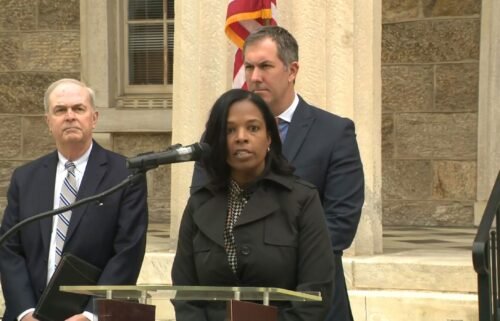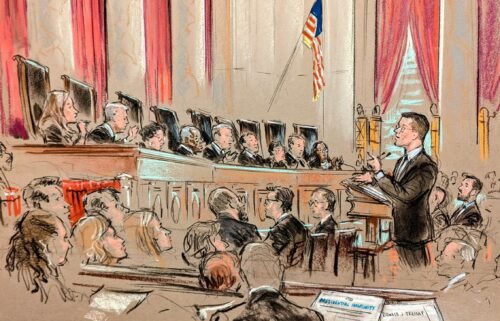There’s a renewed call for police body cameras. Here’s why that may not be the right solution

The calls for police officers to wear body cameras is not new.
They came after Michael Brown was killed in 2014; after Walter Scott was fatally shot in 2015 and they’re ringing out again.
As the cases of Breonna Taylor, George Floyd and Rayshard Brooks reignite protests over police violence, federal legislators, state officials and even law enforcement are again pointing to body cameras as a part of the solution.
But the evidence on whether the technology actually reduces police use of force incidents or changes how communities view departments is mixed.
One study of the Metropolitan Police Department in Washington D.C. — one of the largest, most rigorous reviews of its kind — found that body cameras had no significant impact on officer use of force, on civilian complaints, on whether a case was prosecuted and other outcomes. Another study of the Las Vegas Metropolitan Police Department found that body cameras reduced use of force and civilian complaints only modestly.
“The key is to have realistic expectations about what body worn cameras can accomplish,” says Michael White, co-author of “Cops, Cameras, and Crisis: The Potential and the Perils of Police Body-Worn Cameras.” “… The one thing they can’t do is fix decades of tension between police departments and the minority community.”
The bottom line is this: Body cameras aren’t an easy fix. Rather, experts say, they’re only as effective as the departments that adopt them. And even then, they’re just one piece of a very complicated system.
Here’s why.
Getting cameras is easy. Maintaining them is expensive
By 2016, nearly half of law enforcement agencies in the US had acquired body-worn cameras, according to a Bureau of Justice Statistics survey. it’s likely those numbers now are significantly higher because agencies have been quick to adopt the technology over the years, White said.
But acquiring body cameras is just the beginning.
“Buying the cameras and giving the cameras to officers is the easy part,” says White, who is also a professor of criminology and criminal justice at Arizona State University. “Then it gets extraordinarily complicated and expensive.”
- There’s the cost of the cameras themselves — which can range from about $400 to $800 apiece, depending on the camera make and model and how many a department orders.
- There’s the high costs associated with storing the video footage recorded by the cameras, which can be about $15 to $99 per officer per month. States have varying laws on how long video that could serve as potential evidence must be preserved. For all other video footage, police departments generally set the policies, ranging anywhere from 30 days in Boston to five years in Atlanta, according to the Brennan Center for Justice.
- Then there’s the personnel costs associated with maintaining the footage, says Steven Casstevens, president of the International Association of Chiefs of Police and police chief for Buffalo Grove, Illinois. Police departments need to have employees who are reviewing the videos, responding to public records requests and performing other administrative functions.
Police departments don’t always have a clear plan for their use
For body cameras to be effective, a police department needs to have a proper plan in place.
The Department of Justice has a checklist that law enforcement agencies can consult as they develop policies around how body cameras are used. The International Association of Chiefs of Police also has a set of guidelines around what to consider — such as when a camera should be activated, who reviews the footage, etc.
But in police departments around the US, that’s not always the case.
“There are a variety of ways that a program can fail,” White says. “Certainly one of the ways is that a department hasn’t properly planned out the program.”
At least 19 states and Washington, D.C. require police departments to develop written policies around body cameras, according to the National Conference of State Legislatures. In other localities, departments have taken it upon themselves to do so.
Departments acquire body cameras for a number of reasons. Some departments get them to improve officer accountability and community relations. Others may get them to enhance training, improve evidence quality or make cases easier to prosecute.
In 2017, two organizations — Upturn, a progressive nonprofit that advocates for justice around technology, and The Leadership Conference on Civil and Human Rights — evaluated the body camera policies of 75 local police departments on eight criteria. The measures included whether department rules specified when officers should record; and whether officers were allowed to review footage before writing reports.
At the time, no department fully satisfied all eight criteria, the scorecard found.
“[Body camera policies] are written oftentimes in conjunction with police unions and are oftentimes put in place to benefit department interests and officer interests in a way that I think don’t live up to the promises that mayors and police chiefs have made to communities,” says Harlan Yu, executive director of Upturn.
But Casstevens says police departments should develop their rules in consultation with the communities they serve.
“The arguments come in when a police department just decides to implement a camera program with no input from the public and just says, ‘Well this is how we’re going to run the program,'” he says.
Body cameras aren’t always turned on
One issue that police departments specifically struggle with is getting officers to comply with turning their cameras on when they are supposed to, White says.
“All the goodwill that can be built up by a police chief with the community in terms of rolling out of body-worn camera program and whatever else they’re trying to to do in terms of reform and engagement can be lost almost immediately if there’s a critical incident like a shooting and there should have been footage, but there wasn’t because the officer didn’t activate,” he says.
Most agencies require officers to activate their body cameras when they are dispatched to a call for service, says Daniel Lawrence, a principal research associate at the Urban Institute. That might mean turning on the camera while the officer is in the car, or as they arrive onto the scene, he says.
Having body cameras on at all times can create privacy issues for both officers and members of the public, some in law enforcement argue. But there are technologies that aim to address the discretion an officer has in activating a body camera.
Some models have a “pre-event buffering” setting that captures anywhere from 30 to 120 seconds of video from before the officer presses the button. Others will automatically turn on when an officer activates the car siren, exits the car or pulls their firearm, Lawrence says.
In February, the New York City Civilian Complaint Review Board (CCRB) released a report detailing the challenges the agency had in obtaining evidence from body cameras worn by New York police officers in the first half of 2019.
One of the most significant issues that investigators noted was the failure of officers to activate body cameras according to NYPD policy, the report stated. Some officers turned cameras on late, while others turned them off early. Still others didn’t turn them on at all, according to the report.
Reasons on why officers may not activate their body cameras vary, White said. In some cases, they might forget, while in cases where encounters escalate too quickly, they might not have enough time. Officers might also choose not to activate out of concern for an individual’s privacy. And there may be times where an officer intentionally turns the camera off to escape accountability for misconduct, he says.
A 2015 study of the Anaheim Police Department’s body camera program found that though officers were expected to record all interactions with community members, the degree to which they did so varied widely. The study, conducted by the Urban Institute, found that officers activated their body cameras most often for crime-related interactions, even though such interactions only accounted for about 6% of their overall activities.
Because officers were less likely to activate their body cameras for more routine interactions, such as traffic stops, there could be challenges around investigating citizen complaints around those incidents, the authors wrote.
Even when there is footage, PDs don’t always release it
Footage from body cameras, when it exists, isn’t always made public.
Upturn reviewed fatal police shootings tracked by the Washington Post, and found that out of 105 police killings captured by body cameras in 2017, there were 40 cases where footage wasn’t made public. In 26 out of the 65 cases where video was released, the footage wasn’t made available until one month or later, according to the analysis.
“We’ve seen many, many instances where there has been body worn camera footage, especially of a fatal police shooting,” Yu says. “And after those incidents, oftentimes police departments and cities and prosecutors don’t release that footage in a timely manner.”
In some cases, prosecutors argue that body camera video shouldn’t be publicly released until it’s introduced as evidence in court, for fear that it could taint the jury pool. That was the case in the 2016 shooting of Sylville Smith at the hands of a Milwaukee police officer. Officer Dominique Heaggan-Brown was ultimately found not guilty.
Whether or not body camera footage is subject to public disclosure depends on the laws in the state.
Connecticut, Nevada, North Dakota, Oklahoma and Texas generally categorize body camera recordings as public records, though there are exceptions that allow police to withhold or redact certain videos, according to the National Conference of State Legislatures (NCSL).
In other states, including Florida, Georgia, Illinois, Oregon and South Carolina, body camera footage isn’t subject to open record requests, though some exceptions allow certain people to access recordings in certain situations, NCSL said.
Casstevens says that when police departments withhold body camera footage, the department’s policies should make clear to the public why it isn’t being released.
“There should only be specific instances where the video should not be subject to FOIA,” he says. “And that’s if you’re protecting an ongoing investigation, or if you’re trying to protect the victim’s identity or something like that.”
But if the goal of body cameras is to help provide accountability, other forms of video have proved more beneficial, Yu says.
Bystander video, not body camera footage, brought widespread attention to George Floyd’s death and eventually resulted in protests across the country. A cell phone captured New York police officer Daniel Pantaleo holding Eric Garner in a chokehold.
“It comes down to who has control of the footage, who is willing to release it to the public, to really show what’s happening every day out on American streets,” he says.
The nation has come a long way since calls for American police officers to wear body cameras first began. The technology is now the norm among police departments, and generally, communities view the cameras as a good thing.
It may seem ironic then, that the renewed calls for body cameras are now coinciding with calls to defund or abolish police.
But for body cameras to work as they were intended, experts say they need to be adopted along with other systemic reforms.
Because what’s really at issue, Lawrence says, is how police departments treat civilians — whether the cameras are on or not.



